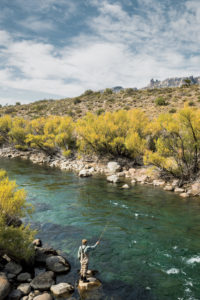SPORTING LIFE
Argentine Dream: Fishing Patagonia
In the estancias of Patagonia, a seasoned angler finds much more than just trophy trout. Come along on the fly-fishing trip of a lifetime, complete with fine wine, outstanding barbecue, majestic countryside, and plenty of requisite siestas. Pura vida, indeed

Photo: Eric Kiel
From left: A nice brown trout prior to release; A gaucho crosses the bridge to the Patagonia River Ranch estancia.
Early on in my very long association with fishing lodges, I could be made happy by pretty much anyplace where the fish were hungry and I was not. Now I am longer on more discriminating appetites and shorter on time, and for me to return to it, a place must have, in addition to good fishing, an effortless rightness of intermeshing components that puts a smile on my face and a song in my heart for as long as I am there: a soul, in short, as sweet and comforting as that of a Jane Austen heroine.
My first visit to Arroyo Verde was in the early nineties, and since then I have revisited it over a dozen times. The place might honestly be said to metastasize rather than grow on you, as do a small number of other guest angling lodges—estancias, as they’re called here—scattered around the northern Patagonia region of Argentina. Like Arroyo Verde, these places set a table for you in some of the earth’s most majestic countryside and then serve up world-class trout fishing rouladed into a highly addictive pura vida of unfussy old-world elegance.
Before you write off that last sentence as journalistic hyperbole, allow me to elaborate by taking you along, so to speak, on a trip my wife, Patricia, and I and a group of friends made this past March to two of these estancias.
A two-hour flight south from the many pleasures of Buenos Aires lands us at the ski and resort town of San Carlos de Bariloche in the lake district of northern Patagonia, hard by the Andes. Two of the people in our group are old and treasured friends from Buenos Aires, Buby Calvo (whose aunt Meme Larivière owns Arroyo Verde) and his wife, Maita Barrenechea. They have arranged a lunch for us just outside Bariloche at an old tavern once frequented by Butch Cassidy and the Sundance Kid, and that afternoon-long feast is a perfect introduction to the Argentine practice of refusing to hurry pleasure. Four courses and numerous bottles of vino tinto later, we collapse into a couple of vans, well fortified for the hour-and-a-half drive to Arroyo Verde along an eye-pleasing route that follows the coiling, turquoise Limay River northward, then turns west toward the Andes into the enchanted Traful River valley.
In 1934, a French expatriate named Felipe Larivière bought the entire twelve-mile-long river and its valley, comprising some thirty thousand acres. After his death the property was divided between his two sons, the south side of the river going to Felipe Larivière and the north to Maurice. On the younger Felipe’s death his estancia, La Primavera, was bought by Ted Turner and remains in his ownership as a (very) private property. In 1975, Maurice and his wife, Meme, built Arroyo Verde on their side of the river, raising on it red deer, horses, cattle, and sheep. As ardent a socialite as he was a fly fisher, Maurice entertained there a host of international celebrities, including Dwight Eisenhower, as well as virtually every high-profile trout fisherman of the day. Joe Brooks, Ernie Schwiebert, A. J. McClane, Mel Krieger, and others came, fished, and talked or wrote encomiums on the fishing in the Traful.

Photo: Eric Kiel
From left: A drift boat at Arroyo Verde; a guest cottage at Arroyo Verde.
Since now, as then, the only way to fish the river is by staying at Arroyo Verde or La Primavera, Maurice did all anglers outside his circle of friends a kindness when, in 1987, he opened the estancia to paying guests, and Meme does us all an equal one by continuing to operate it as such, thirteen years after her husband’s death, despite offers as large as the GDP of some small countries to sell into hedge-funder hands.
Those kindnesses are inestimable primarily because the Traful is not just another place to wet a line. Of the very few rivers anywhere that offer true trophy fishing for two species of trout as well as landlocked salmon, it is almost unquestionably the finest in the world. Though it is neither easy to fish well nor generally productive of large numbers, any cast into the Traful may bring you tight to an eight- to ten-pound (or larger) rainbow, brown, or landlocked salmon—and that, Toto, is not fishing in Kansas.
But Arroyo Verde is by no means all about the fishing. There is, for example, the raw, breathtaking beauty of its landscape—the buttes and mesas and rococo rock outcroppings, and beyond them the notched and lapstrake layers of towering Andean foothills, all of it clothed in a silence clamorous to modern ears. At the end of a twelve-mile private dirt road, the embracing sharp-edged wildness makes our arriving at the estancia feel like stepping through a gate into an English garden.
Then there is the estancia itself. The main house is large and handsome, made of glass, stone, and wood, and surrounded by expanses of green lawn, flowering shrubs, and rosebushes. Labradors rise off the grass to greet you. A cat stretches on a stone wall. Placed well back from the main house are a guesthouse, a tack room and barn, and lodging for the estancia’s staff and fishing guides—all as natural in their settings as if they had grown there. Looking around from the stone terrace on your arrival, you may be struck, as I am on every visit, by how perfectly harmonious everything appears here, poised in a nonchalant but precise balance of pleasurable effects best described as exactly right.
After you are welcomed as if you were family by Meme’s daughter Marina Larivière and the estancia manager, Katrena Gibb-Stuart, and taken inside, you will find that harmony following you, peeking out from the old silver and fine china in the dining room, the good art on the walls and books on the coffee tables, the monogrammed linen sheets in your bedroom and plush towels in your bath. And you will find, moreover, that it characterizes the pace of the days here.
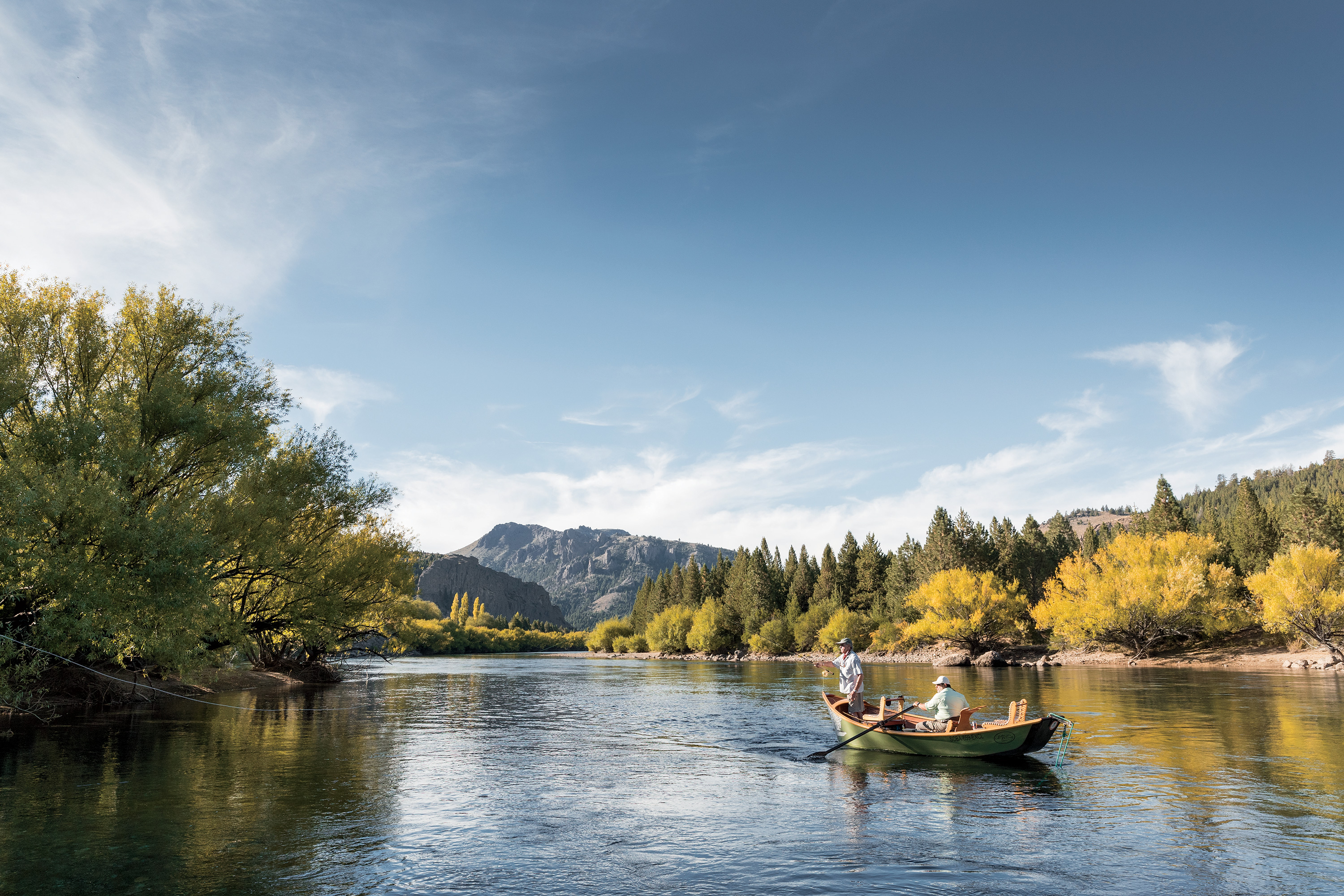
Photo: Eric Kiel
The author throws a loop on the Limay River with Gonzalez-Vicens at the oars.
Fishing no more than eight rods, the Traful is a wading river whose thirty-three named pools and runs are all within a thirty-minute drive from the estancia, which means that you can pretty much set your own fishing schedule (for nonanglers there are spectacular hiking and horseback riding). A typical day might amble along like this:
After a leisurely breakfast at 8:30, you and I are met outside the main house by Gonzalo Detry, one of Arroyo Verde’s peerless guides, and are driven down to a pool I have requested for us—as I would if I were somehow informed that I had to pick one trout pool to be the only one I could ever fish. It is called Tranquera, and it is as much a joy to behold as it is to angle: a small rapids at the head emptying into a smooth hundred-yard run, deep near the red cliff that forms the opposite bank and tailing off into a textbook dry-fly flat beneath willows.
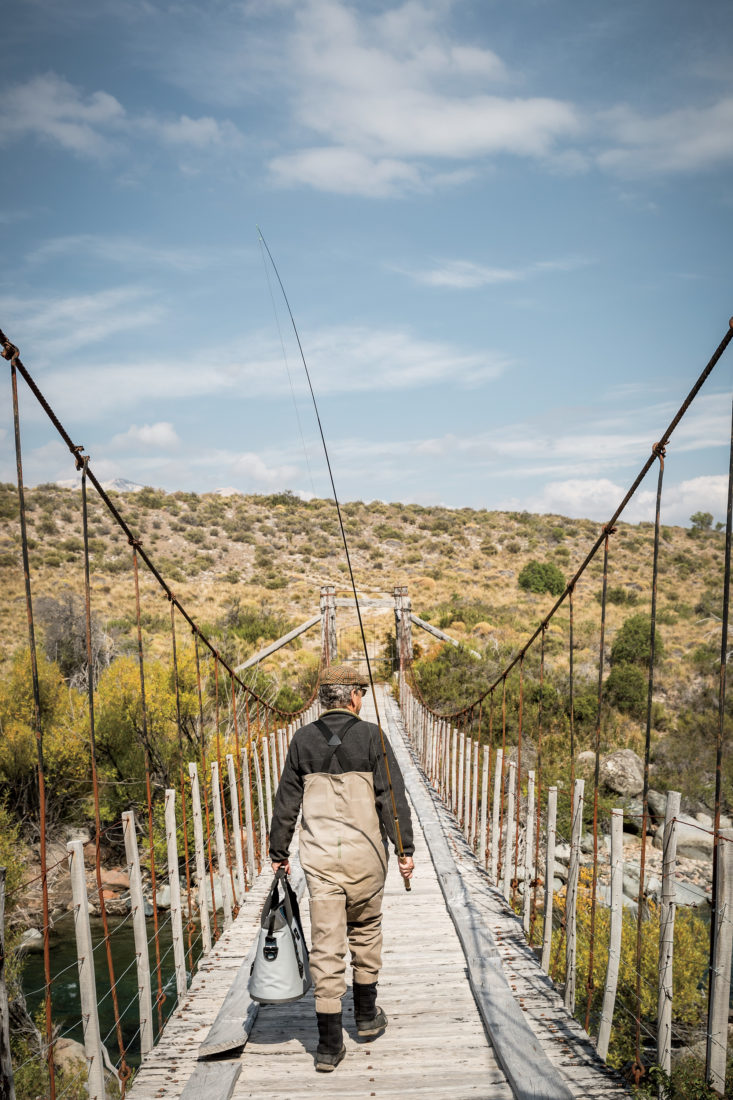
Photo: Eric Kiel
Buby Calvo on the hunt for fish.
A few years ago my veteran fishing pal Temple Tutwiler and I hit the magic hour before and into dark just right and caught in the run three brown trout over twenty-five inches and a rainbow that taped a half inch over thirty, and I have been broken off here numerous times by fish too big to stop. It is now early fall in Patagonia. Red stags are bugling from the hills; the alamo and maiten trees are yellowing; a rare silver fox strolls the cliff top across from us against a backdrop that looks like a John Ford stage set.
At 1:00 we meet the rest of our group on the deck of the lake cabin for prelunch pisco sours and hors d’oeuvres. About a mile from the main house, this cabin is one of the guest accommodations here and may well be the single most idyllic site on the planet for couples to come to terms. Perched on a stone cliff where the river exits Traful Lake, it commands a near-limitless view of the twenty-seven-mile-long astonishingly blue mountain-ringed lake. The combination of that view, the good fishing of the morning, the perfect weather, and, yes, the pisco sours makes it difficult for any of us to recall that we inhabit a vale of tears. And not a single person on the deck is texting.
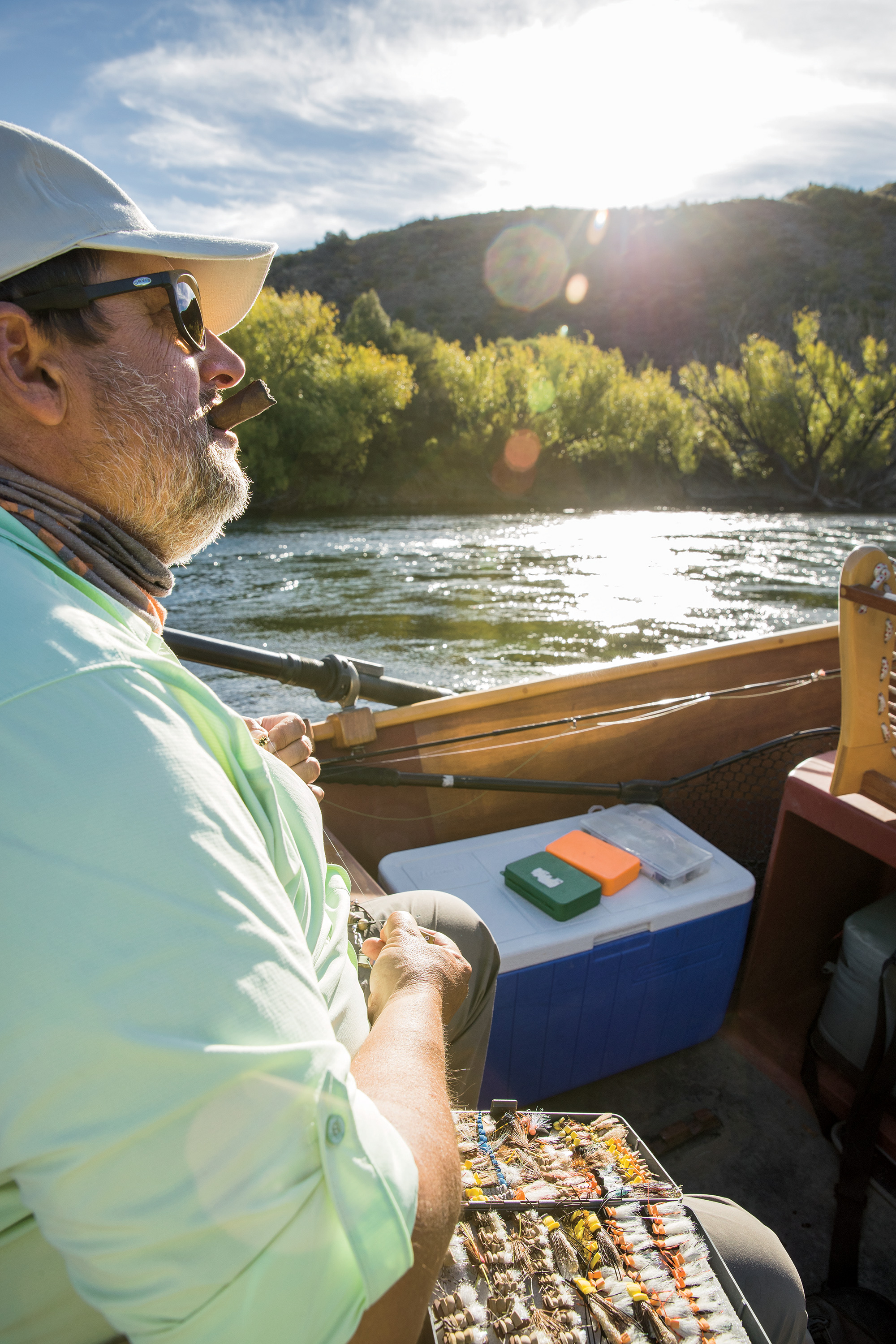
Eric Kiel
We are due to return at 2:00 to the main house for a lunch of borscht with estancia-made sour cream served in Spode bowls, an eggplant soufflé, and more than one bottle of authoritative malbec, followed by a siesta, more fishing between 5:30 and dark, then cocktail hour and dinner at 10:30 or 11:00—but it is now 2:30 and no one is moving. My friend Nancy Dunlap Johns—a fine angler, a vividly accomplished physician, and recently the dean of the University of Virginia School of Medicine—comes up to me with a smile as sweet as any Jane Austen heroine’s, and observes, “It is wonderful how people here take time, make the time, for living well.”
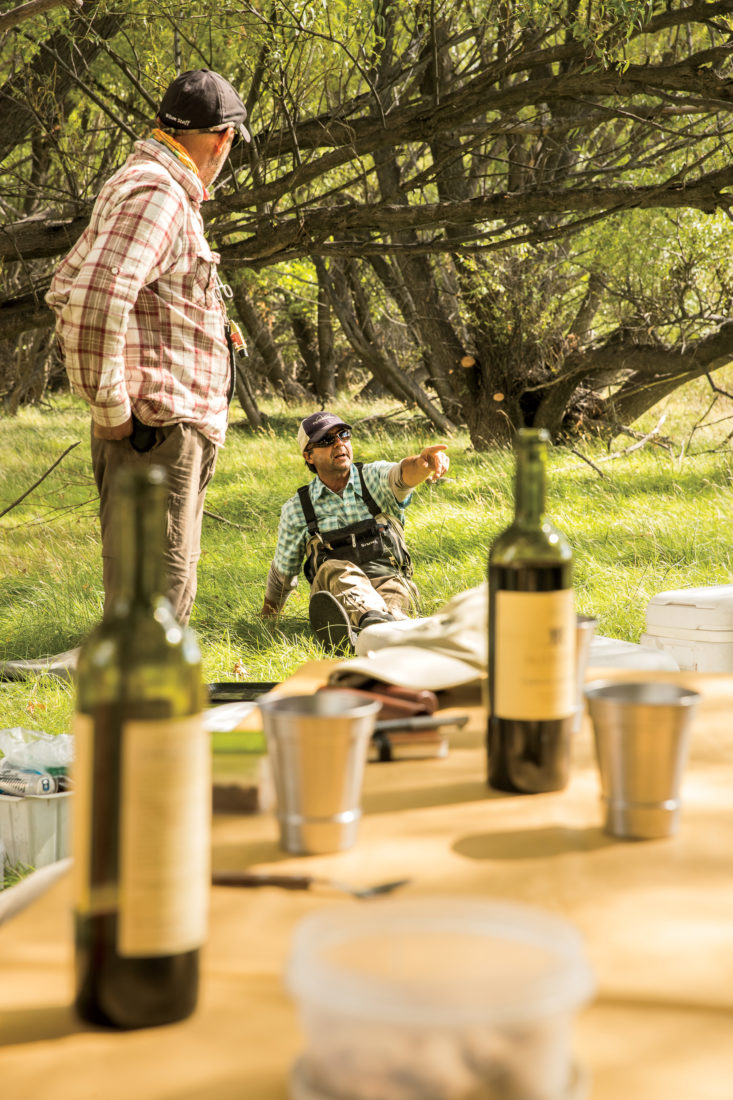
Photo: Eric Kiel
Lunch at Patagonia River Ranch.
At expending both the time and the effort to provide the Patagonian pure life to paying guests, few people can match Ken Gangwer, a tall, fit seventy-four-year-old real estate broker from Jackson Hole, Wyoming, and the owner of Patagonia River Ranch. When he bought the six-hundred-acre estancia on the Chimehuin River in 1996, it had on it no buildings and one tree. By the time he opened it to guests in 2001, he had done nothing less than the following: built a beautifully appointed seven-bedroom main house of native logs and stone, two guest cottages, a barn and stables, a garage, and guide cabins; surrounded the house with lawn and a rose garden containing more than two hundred varieties; planted three hundred of his cattle-scavenged acres with wild pampas grass, two hundred thousand seedling pines, and forty-two thousand poplars, willows, and birches, and installed forty-eight miles of pipe to irrigate those plantings; and put in an acre of organic vegetable garden, an apple, pear, and cherry orchard, a half-acre berry patch, a commercial-size greenhouse, and a chicken coop. On the seventh day, one hopes, he rested.
I visited Patagonia River Ranch for the first time three years after it opened and it was already a first-class angling estancia. Due to Gangwer’s tireless fine-tuning, on each of my subsequent visits what seemed hard to improve was improved, and during our stay there in March the place appeared to operate, like Arroyo Verde, on some otherworldly plane of making the difficulties of providing seamless, stylish, unostentatious pleasure and comfort to its patrons look easy.
The provisioners of all that sprezzatura—a staff of thirty-six men and women for a maximum of sixteen guests—are lined up outside to greet us after a three-hour drive from Arroyo Verde. Among them are Salome Audisio, the comely and fiercely efficient guest manager; Claudio Abraham, the three-star head chef; a gardens manager; a ranch manager; a sommelier; and eight of the most amiable and expert fishing guides in Argentina, who hold an average of ten years’ tenure at the ranch.
Such long-term experience as a guide is critical at Patagonia River Ranch, since the estancia offers daily fishing on a larger variety of Blue Ribbon trout rivers than any other in northern Patagonia: the Chimehuin, legendary for its big brown trout, on which it occupies a mile of frontage, the Collon Cura, the Malleo, the Caleufu, the Alumine, and the Quilquihue. Most of that fishing is done from rafts and requires not only extensive knowledge of where the trout are to be found but also where the rocks and rapids are to be avoided, and I know of no fishing operation anywhere (except for the outstanding Patagonia River Guides in southern Patagonia) where the guides are as skilled on as bewildering a mix of water as those working for Gangwer. Like everyone else working for him at Patagonia River Ranch, they are Argentine, speak fluent English, and throw themselves wholly and happily into their work.

Photo: Eric Kiel
One of the cabins at Arroyo Verde.
It is a perfect, windless morning on our third day here. On the past two days you and I have had excellent fishing on the Chimehuin and the Collon Cura, and today we are floating the Alumine with one of the two head guides, Santi Oliver. After an hour’s drive north, we cross the Malleo, arguably the world’s premier dry-fly river, and wind through a Mapuche Indian reservation to our put-in. On the same float with us today in their own raft are Johnny and Nancy Johns, and in the raft with you and me is my wife, Patricia. Like a couple of others in our group, Patricia does not fish. On fine days like this one, she enjoys floating the broad, beautiful Alumine or the equally fetching Collon Cura, but if she is otherwise inclined, Patagonia River Ranch is the best in the business at entertaining nonangling guests with escorted horseback rides, bike or hiking tours, or trips to the nearby resort town of San Martín de los Andes, a sort of South American Chamonix of fifty years ago.
Our raft is a comfortable fourteen feet, fitted at bow and stern with standing braces from which throughout the morning the dry-fly fishing steadily produces sixteen- to nineteen-inch browns and rainbows. The Alumine strolls, obliging its pace to the drift of our flies, and with the sun at our backs, all downriver is a bright sheet of sparkling invitation. We put up ducks, Magellan geese, a fishing eagle from a tree. Just before lunch at a wide riffling drop-off, we hang nymph droppers off our dry flies and for fifteen minutes catch one high-flying rainbow after another on the nymphs, four of them over twenty inches.
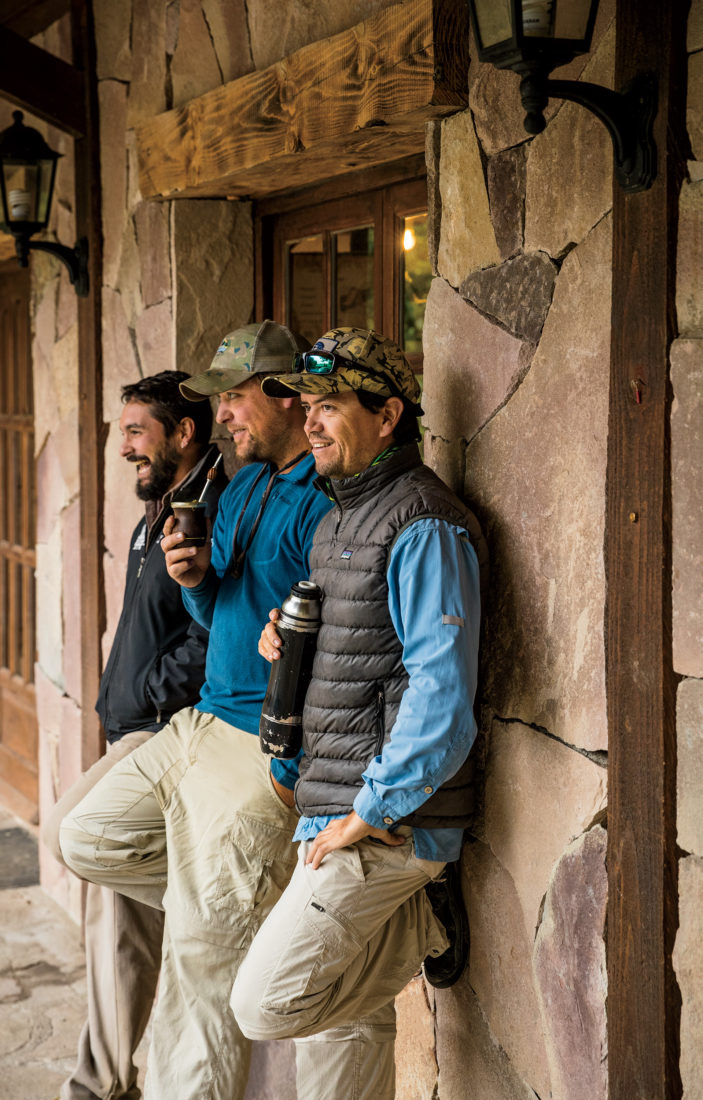
Photo: Eric Kiel
Guides at Patagonia River Ranch after a day on the water.
We lunch with the Johnses beneath some willows on a wide sandy bank, sitting down in camp chairs at a clothed table to chicken roulade and an Argentine tarta made of eggs, potatoes, onion, and sausage. That is followed by coffee, a stogie, a siesta if anyone is in the mood—and that by an afternoon of more memorable trout fishing, yarning in the raft, and marinating our spirits in the wild, incomparable landscape.
Technically, an asado is a gaucho-derived barbecue, usually featuring a whole lamb butterflied on a metal cross and roasted for four or five hours before a banked wood fire. But in the life of Argentine angling estancias, an asado is about much more than simply cooking meat. It is a ritualistic feast, normally held at the end of one’s stay at an estancia and celebrating the particular character of that place, and the fishing and camaraderie with friends old and new that you have had there. It is typically a boisterous event with many toasts and much laughter. In the more than fifty of them that I have attended over the years, I have never seen a dour face, and if I ever do I will flee from it, for—to paraphrase Samuel Johnson—a man or woman who is dour on asados is dour on life.

Photo: Eric Kiel
An asado at Patagonia River Ranch.
Granted, it is unlikely, but if I ever find myself in Angola penitentiary being asked by a warden what I should like for a last meal, my modest request would be that he immediately fly Claudio Abraham up to Louisiana to prepare precisely the asado he prepared on our last night for the guests, guides, and some of the staff at Patagonia River Ranch. I would ask for the same long table lit by candles, the sultry tango music from a boom box, the toothsome young Argentine women dressed in silver belts, boots, serapes, and berets. And I would request an identical menu of grilled sausages, lamb, beef, and red deer, accompanied by similar torrents of death-defying malbec. I would choose for company the same A-Team of fellow travelers; and when the evening was over, before they led me back to my cell, I would rise and propose to them this toast:
“To the Patagonian pura vida. Grab it while you can, brothers and sisters!”


